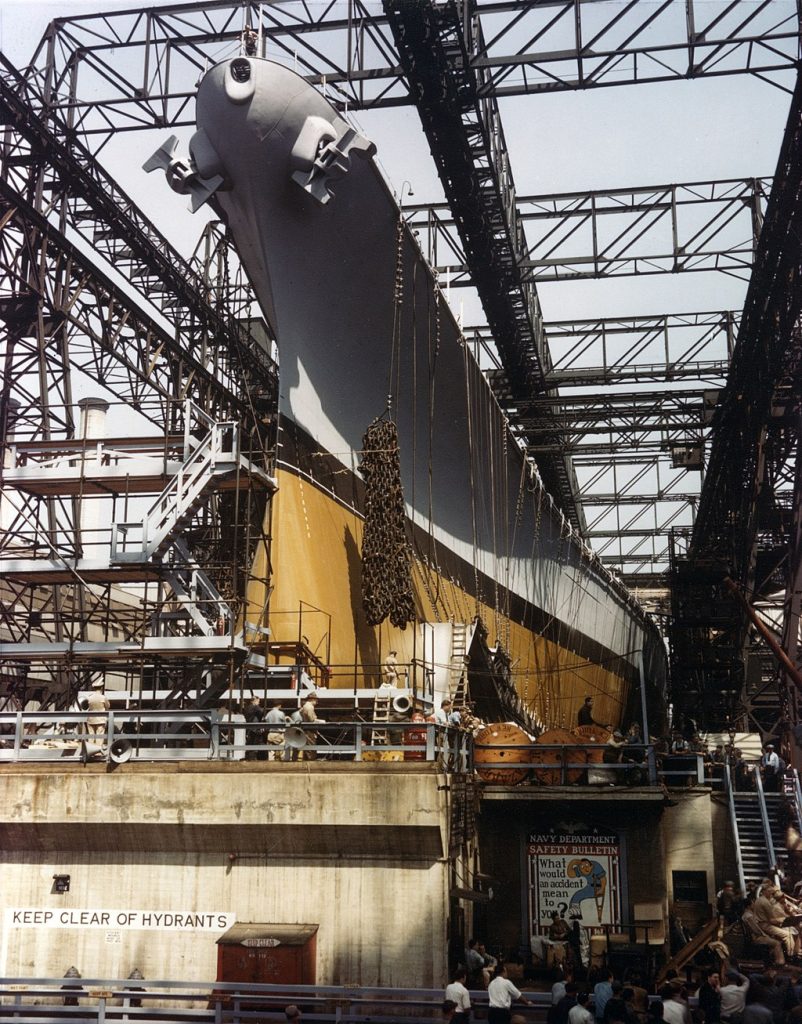The incident involving the USS William D. Porter (DD-579) mistakenly firing a torpedo at the USS Iowa (BB-61) is a notable and rather unusual event in U.S. naval history.
At the time of the incident, the USS Iowa was transporting President Franklin D. Roosevelt across the Atlantic to Mers-el-Kébir, Algeria, for a conference with Allied leaders in Tehran and Cairo.
The USS William D. Porter, a Fletcher-class destroyer, was among the ships assigned to escort the Iowa on this critical mission.
The USS Iowa (BB-61) is a remarkable example of American naval engineering and military history, representing the peak of battleship design when she was launched. She is the lead ship of the Iowa-class battleships.
Design Specifications:
The Iowa was designed primarily for speed and firepower, with the intention of outmatching any enemy battleship while being fast enough to operate with aircraft carrier task forces. She stretched 887 feet in length and displaced about 57,000 tons when fully loaded.
Her main battery consisted of nine 16-inch (406mm) guns arranged in three triple turrets, capable of firing shells up to 24 miles. This firepower was complemented by twenty 5-inch guns, and anti-aircraft guns.
 USS Iowa before her launch in 1942.
USS Iowa before her launch in 1942.
The Iowa’s armor was formidable, with belt armor up to 12.1 inches thick and turret faces up to 17 inches thick, designed to withstand gunfire from other battleships. Her engines were capable of propelling her at speeds in excess of 33 knots, making her one of the fastest battleships ever built.
Commissioned in February 1943, the USS Iowa’s service history spans several decades, reflecting her versatility and adaptability. During World War II, she served in both the Atlantic and Pacific theaters, performing a variety of roles from escorting convoys to bombarding enemy shore positions.
Background
In November 1943, the USS Iowa was entrusted with a mission of utmost secrecy and importance: to safely transport President Franklin D. Roosevelt across the treacherous waters of the Atlantic to North Africa.
The president was scheduled to attend the Tehran Conference, an unprecedented meeting with British Prime Minister Winston Churchill and Soviet Premier Joseph Stalin.
The conference was crucial for planning the Allied strategy for the ongoing war in Europe and Asia, making Roosevelt’s safe passage a matter of international significance.
 USS Iowa in a floating drydock, December 1944.
USS Iowa in a floating drydock, December 1944.
To ensure the president’s security, a convoy was assembled, including the USS William D. Porter, a Fletcher-class destroyer launched in 1942.
The Porter, like the Iowa, was a product of America’s wartime industrial surge, designed to escort larger ships, conduct anti-submarine warfare, and provide gunfire support for amphibious landings.
Her assignment to the presidential convoy was a testament to the Navy’s confidence in her capabilities and her crew’s proficiency. However, this mission would prove to be an unexpected test of the crew’s readiness and decision-making under pressure.
A Torpedo is Heading for the Iowa
On November 14, 1943, as the convoy made its way across the Atlantic, the crew of the William D. Porter engaged in a series of training exercises. These drills were standard practice, designed to ensure readiness and efficiency in the face of enemy action.
The exercises ranged from gunnery drills to torpedo launching procedures, the latter of which would become the focus of an extraordinary blunder.
The objective was to simulate an attack on a high-value target, in this case, the USS Iowa, to test the crew’s ability to respond swiftly and accurately. The drill was intended to be a controlled demonstration with no torpedoes actually being fired.
 The destroyer William D. Porter pictured in 1943.
The destroyer William D. Porter pictured in 1943.
However, through a confluence of human error, oversight, and perhaps a lapse in communication, a torpedo was launched.
The realization of the error triggered a frantic response from the crew. Initial attempts to warn the Iowa utilized signal lamps, a method chosen perhaps in an attempt to maintain silence for fear of enemy detection.
This choice, while understandable from a security standpoint, proved ineffective. The urgency and specificity of the message—that a live torpedo was speeding towards the Iowa—failed to be conveyed adequately through this method.
Recognizing the gravity of the situation and the imminent threat to the Iowa, and by extension, to President Roosevelt himself, the William D. Porter broke radio silence.
This act, while necessary under the circumstances, was a significant deviation from protocol, reflecting the dire nature of the mistake. The message was clear: a torpedo was in the water, and it was heading straight for the Iowa.
The Response From the Iowa
Upon receiving the urgent and unexpected warning of an incoming torpedo, the USS Iowa’s crew sprang into action. The battleship, a leviathan of steel and firepower, was suddenly in a race against time.
The Iowa’s commanding officer, fully aware of the precious cargo the ship carried, ordered immediate evasive maneuvers.
This directive set the battleship into a series of high-speed, sharp turns designed to create a moving target that was much harder for the torpedo to hit.
Meanwhile, on the deck of the Iowa, a remarkable scene unfolded involving President Roosevelt himself. Informed of the incoming torpedo and the potential danger, Roosevelt expressed a desire to witness the event firsthand.
 USS Iowa had a bath tub fitted for President Roosevelt.
USS Iowa had a bath tub fitted for President Roosevelt.
His security detail, tasked with protecting the President at all costs, was understandably less enthusiastic about this idea. In a moment that underscored Roosevelt’s character he was moved to the ship’s edge. Reports suggest that the Secret Service prepared to lift the President, wheelchair-bound due to polio, into a lifeboat if the torpedo struck.
However, thanks to the Iowa’s evasive actions, the torpedo would detonate 2,700 meters astern in the ship’s wake just four minutes after it was launched.
The Aftermath
The immediate aftermath of the incident was marked by a flurry of activity aimed at understanding how such a grave mistake could have occurred. The Navy launched a thorough investigation to ascertain the details of the mishap, scrutinizing every action leading up to the torpedo’s launch.
This inquiry was not merely procedural; it was critical in determining whether the incident was an act of sabotage, a grave error in judgment, or a failure of protocol. The stakes of the investigation were high, given the potential implications for national security and the safety of the President.
The investigation led to the finding that the Chief Torpedoman Lawton Dawson failed to remove the primer from the torpedo which allowed it to launch. He was going to be sentenced to hard labor, but the President stepped in and granted Dawson with a pardon.
After the inquiry, the USS William D. Porter went back to regular service. But, in true military fashion, other ships and sailors were not going to let the crew of the William D. Porter get off lightly. The ship would frequently be greeted with “Don’t shoot! We’re Republicans!”, due to President Roosevelt being a Democrat.
The Tehran Conference
The Tehran Conference, held from November 28 to December 1, 1943, was a pivotal meeting during World War II between the three main Allied leaders: President Franklin D. Roosevelt of the United States, Prime Minister Winston Churchill of the United Kingdom, and Premier Joseph Stalin of the Soviet Union.
This was the first time the three leaders met together, and the conference took place in Tehran, Iran. The primary aim was to coordinate the military strategies of the Allies against the Axis powers and to discuss the post-war reorganization of Europe and the world.
Here’s Some of the Key Points of the Tehran Conference:
Opening a Second Front in Western Europe: One of the most significant agreements was the commitment to open a second front against Nazi Germany by launching Operation Overlord, which would become the D-Day invasion of Normandy, France, in June 1944. This was a critical step in coordinating Allied efforts to ensure the defeat of Germany.

Division of Germany: The leaders discussed the post-war division of Germany, laying the groundwork for what would eventually become East and West Germany. This division reflected the differing political ideologies and security concerns of the Allies and the Soviet Union.
Support for the Soviet Union: The conference also addressed the need for increased support and supplies to the Soviet Union from the Western Allies to aid in the Soviet war effort on the Eastern Front.
Post-War Reorganization: The Tehran Conference set the stage for the creation of the United Nations, with discussions on the need for an international body to replace the failed League of Nations in maintaining peace and security worldwide.
Poland and Eastern Europe: There were discussions on the future borders of Poland, with Stalin advocating for a shift of Poland’s borders to the west, which was met with some resistance from Roosevelt and Churchill. This topic would remain contentious and was further addressed in later conferences.
The Tehran Conference was crucial in solidifying the cooperation between the United States, the United Kingdom, and the Soviet Union. It helped to coordinate the Allied strategies that would eventually lead to the defeat of Nazi Germany.
The USS Iowa’s Later Service History
After her duties in the Atlantic, the Iowa was transferred to the Pacific Theater, where she participated in several key operations against Japanese forces. She played roles in the Marshall Islands campaign, the Battle of the Philippine Sea, and the bombardment of Japanese positions on the islands of Kwajalein and Eniwetok.
The USS Iowa also participated in the Leyte Gulf operations, the invasion of Okinawa, and provided gunfire support for troops landing on various Japanese-held islands.
After World War II, the USS Iowa was briefly decommissioned in 1949 but was quickly recommissioned in 1951 to serve in the Korean War.
During this conflict, she provided naval gunfire support against North Korean and Chinese forces, bombarding enemy positions and supporting United Nations troops on the ground.
 USS Iowa firing on North Korean positions in 1952.
USS Iowa firing on North Korean positions in 1952.
Her powerful 16-inch guns were particularly effective in destroying enemy targets and infrastructure. After the Korean War, the Iowa was again decommissioned in 1958.
The USS Iowa was brought back into service in the 1980s as part of the U.S. Navy’s modernization efforts during the Reagan administration.
She underwent significant upgrades, including the addition of Tomahawk cruise missiles and Phalanx close-in weapon systems, enhancing her capabilities to meet the demands of modern naval warfare.
The Iowa served as a key asset in the U.S. Navy’s surface fleet, participating in exercises and operations intended to project power and deter Soviet aggression during the latter years of the Cold War.
The USS Iowa was decommissioned for the last time in 1990. After several years in the reserve fleet, she was donated as a museum ship.
Today, the USS Iowa is moored at the Port of Los Angeles in San Pedro, California, where she serves as a museum, allowing visitors to explore her decks, learn about her service history, and understand the role of battleships in naval warfare





